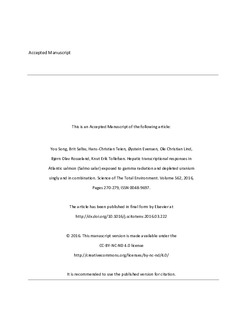| dc.contributor.author | Song, You | |
| dc.contributor.author | Salbu, Brit | |
| dc.contributor.author | Teien, Hans-Christian | |
| dc.contributor.author | Evensen, Øystein | |
| dc.contributor.author | Lind, Ole Christian | |
| dc.contributor.author | Rosseland, Bjørn Olav | |
| dc.contributor.author | Tollefsen, Knut Erik | |
| dc.date.accessioned | 2018-10-05T08:54:29Z | |
| dc.date.available | 2018-10-05T08:54:29Z | |
| dc.date.created | 2016-05-10T14:20:03Z | |
| dc.date.issued | 2016 | |
| dc.identifier.citation | Science of the Total Environment. 2016, 562, 270-279. | nb_NO |
| dc.identifier.issn | 0048-9697 | |
| dc.identifier.uri | http://hdl.handle.net/11250/2566605 | |
| dc.description.abstract | Radionuclides are a special group of substances posing both radiological and chemical hazards to organisms. As a preliminary approach to understand the combined effects of radionuclides, exposure studies were designed using gamma radiation (Gamma) and depleted uranium (DU) as stressors, representing a combination of radiological (radiation) and chemical (metal) exposure. Juvenile Atlantic salmon (Salmo salar) were exposed to 70 mGy external Gamma dose delivered over the first 5 h of a 48 h period (14 mGy/h), 0.25 mg/L DU were exposed continuously for 48 h and the combination of the two stressors (Combi). Water and tissue concentrations of U were determined to assess the exposure quality and DU bioaccumulation. Hepatic gene expression changes were determined using microarrays in combination with quantitative real-time reverse transcription polymerase chain reaction (qPCR). Effects at the higher physiological levels were determined as plasma glucose (general stress) and hepatic histological changes. The results show that bioaccumulation of DU was observed after both single DU and the combined exposure. Global transcriptional analysis showed that 3122, 2303 and 3460 differentially expressed genes (DEGs) were significantly regulated by exposure to gamma, DU and Combi, respectively. Among these, 349 genes were commonly regulated by all treatments, while the majority was found to be treatment-specific. Functional analysis of DEGs revealed that the stressors displayed similar mode of action (MoA) across treatments such as induction of oxidative stress, DNA damage and disturbance of oxidative phosphorylation, but also stressor-specific mechanisms such as cellular stress and injury, metabolic disorder, programmed cell death, immune response. No changes in plasma glucose level as an indicator of general stress and hepatic histological changes were observed. Although no direct linkage was successfully established between molecular responses and adverse effects at the organism level, the study has enhanced the understanding of the MoA of single radionuclides and mixtures of these. | nb_NO |
| dc.language.iso | eng | nb_NO |
| dc.publisher | Elsevier | nb_NO |
| dc.rights | Attribution-NonCommercial-NoDerivatives 4.0 Internasjonal | * |
| dc.rights.uri | http://creativecommons.org/licenses/by-nc-nd/4.0/deed.no | * |
| dc.title | Hepatic transcriptional responses in Atlantic salmon (Salmo salar) exposed to gamma radiation and depleted uranium singly and in combination | nb_NO |
| dc.type | Journal article | nb_NO |
| dc.type | Peer reviewed | nb_NO |
| dc.description.version | acceptedVersion | nb_NO |
| dc.source.pagenumber | 270-279 | nb_NO |
| dc.source.volume | 562 | nb_NO |
| dc.source.journal | Science of the Total Environment | nb_NO |
| dc.identifier.doi | 10.1016/j.scitotenv.2016.03.222 | |
| dc.identifier.cristin | 1354821 | |
| dc.relation.project | Norges forskningsråd: 178621 | nb_NO |
| dc.relation.project | Norges forskningsråd: 160016 | nb_NO |
| dc.relation.project | Norges forskningsråd: 223268 | nb_NO |
| cristin.unitcode | 7464,20,13,0 | |
| cristin.unitname | Økotoksikologi | |
| cristin.ispublished | true | |
| cristin.fulltext | postprint | |
| cristin.qualitycode | 2 | |

